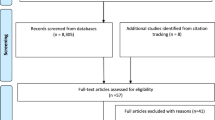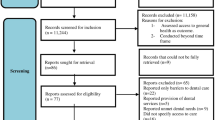Abstract
Data sources
The Medline, Embase and CINAHL databases were searched together with the reference lists of selected publications.
Study selection
Studies published since January 1990 and published in English that looked at barriers, experienced by dentists, to delivering oral health care to people over the age of 65 were included. Study quality was assessed independently using criteria developed by the Dutch Cochrane Centre.
Data extraction and synthesis
Study assessment and data extraction were carried out independently by two reviewers and a qualitative summary presented.
Results
Seven cross-sectional studies were included. The focus was primarily on dentists delivering oral health care to older people in care homes with only one focused on barriers experienced by dentists working in their own practice and delivering oral health care to community-dwelling older people. The most common barriers to delivering oral health care to older people were identified respectively as: the lack of adequate equipment in a care home and no area for treatment available (n = 4) and the lack of adequate reimbursement for working in a care home (n = 5). In addition, the inadequate training and experience in delivering oral health care to older care home residents (n = 2) were mentioned. Four publications indicated the loss of time from private practice as a barrier to delivering oral health care in a care home.
Conclusions
Most articles retrieved described barriers experienced by dentists delivering oral health in care homes: much less is known about oral health care for community-dwelling older people. Therefore, we suggest that additional research should be initiated to investigate in more detail the barriers dentists experience in delivering oral health care to older people in their own dental practices.
Similar content being viewed by others
Commentary
The World Health Organisation report that an increasing proportion of older people in the population is a significant worldwide trend and that the global average life expectancy from birth is now 70 years.1 In 2010 it was estimated that there were around 10 million people over the age of 65 living in the UK.
Current government projections predict that there will be around 5.5 million more elderly people in the UK by the year 2030.2 The growing number of older people has implications for oral health care delivery and will require the development of care pathways that are ‘centred around need, evidence-based, responsive to setting and take into account current social care models, payment systems and local priorities and circumstances’.3 It has been shown that a wide range of factors contribute to older people being less frequent users of dental services.4
Evidence also suggests that the provision of oral health care training and support for staff in the elderly care home setting is generally lacking.5
The barriers faced by dental professionals, patients and others involved with their care warrants investigation in order to inform planning for future service delivery. This review considers the barriers experienced by dentists during the provision of oral health care to older people. The term ‘oral health care’ is used by the authors to describe the delivery of dental treatment and in this context, should not be confused with the provision of day-to-day oral hygiene.
In the review three relevant databases (PubMed, Embase and CINAHL) were searched for articles that described ‘barriers of delivering oral health care to older people experienced by dentists’. Reference lists of the retrieved articles were examined for additional relevant publications although attempts to retrieve additional, unpublished or grey literature are not suggested within the review. By including further databases and, or extending the search to include unpublished literature it is possible that additional articles, such as that of White et al.5 may have been found.
The search was restricted to English language articles that detailed descriptive questionnaire type studies. A further limitation imposed by the reviewers was to include only those articles published between January 1990 and December 2011. The authors reasoned that there had been significant advances in gerodontology since 1990.
It is, however, reasonable to suggest that barriers to providing dental care for this age group have remained much the same and additional relevant articles may have been retrieved were the search extended beyond this restricted period. The authors table a comprehensive literature search although, of note as potentially limiting, ‘domiciliary’ which is a commonly used term in the healthcare context, appears as neither a MeSH nor free text term. The population to be studied was limited to those over 65, although the MeSH term older people definition of ‘aged 80 and over’ was also used within the search.
Articles to be included were assessed for methodological quality using criteria defined by the Dutch Cochrane Centre (www.dcc.cochrane.org). A description of the scoring system is provided within the review. This quality assessment is not without limitations, as it appears to be an accumulative type scoring system with potential to allow areas of good quality within a study design to compensate for those of lesser quality. The calculated quality score for each of the papers reviewed is not provided. Further quality controls, such as a risk of bias assessment, were not carried out.
Two hundred and thirty six publications were identified in the initial search. After screening, seven studies remained which met strict inclusion criteria. All of the articles reviewed contained descriptive studies with a cross sectional design and were representative of western countries. It was acknowledged that only one of the publications related to the treatment of patients in their own homes, the remainder described barriers faced by dentists providing treatment within a care home setting.
Participation rates for each of the studies were tabled and ranged from 2% to 66%. Five of the seven studies had a response rate of less than 60%, potentially limiting their significance through the reduced power of the ‘effective’ sample and non-responder bias. In addition, the quality of the included studies may be less than expected nowadays, as methodologies have improved over time.
The authors provide a basic review for each article. This includes a brief account of the study design and participants involved. The percentage per response for each barrier is noted for six of the seven studies. No further descriptive statistics were included for these studies.
The remaining study examined responses by exploratory factor analysis and provided a ‘loading score’ between zero and one which was reported as thus by the reviewers.
The consistent responses identified found that lack of adequate dental equipment in a care home, concern for private practice and lack of adequate reimbursement were the most commonly reported barriers in the review publications. Lack of training and experience in providing oral care for this age group was also mentioned as a barrier. Dentists reported that they were inadequately educated in this field of practice and felt insecure on making treatment decisions; both are areas that should be addressed to minimise the impact on future service delivery.
Several of the studies also recognised that providing domiciliary care is complicated because of the medical and dental issues associated with the aging population.
The reviewers acknowledge shortcomings in the breadth of locations that were retrieved and are correct to highlight the lack of evidence available on barriers to dentists providing dental care for older people in their own homes. There are limitations with regard to the content analysis of this literature evaluation. There remains potential to explore these themes within a theoretical framework or simply to compare and contrast the views of dentists with those of patients and other individuals involved their care.
The authors have provided a narrative review making use of a systemic framework to select relevant articles, nonetheless, in doing so they have highlighted some of the challenges facing dentists when providing care to older people. In light of the aging population and the fact that many will retain their natural dentition into old age this has important implications for future healthcare services and therefore, as the reviewers conclude, warrants further investigation.
References
World Health Organisation. Global Health and Ageing. NIH Publication No. 11-7737. Geneva: WHO; 2011.
House of Commons Library Research. Key Issues for the New Parliament 2010. London: House of Commons Library; 2010.
Pretty IA . The life course, care pathways and elements of vulnerability. A picture of health needs in a vulnerable population. Gerodontology 2014; 31: 1–8.
Tennstedt SL, Brambilla DL, Jette AM, McGuire SM . Understanding dental service use by older adults: sociobehavioral factors vs need. J Public Health Dent 1994; 54: 211–219.
White VAA, Edwards M, Sweeney MP, Macpherson LMD . Provision of oral healthcare and support in care homes in Scotland. Journal of Disability and Oral Health 2009; 10: 99–106.
Author information
Authors and Affiliations
Additional information
Address for correspondence: Pieternella C Bots-VantSpijker, Department of Oral Function and Prosthetic Dentistry, Radboud University, Nijmegen Medical Centre, PO Box 9101, Nijmegen 6500 HB, The Netherlands. E-mail: bots@filternet.nl
Bots-Vantspijker PC, Vanobbergen JN, Schols JM, Schaub RM, Bots CP, de Baat C. Barriers of delivering oral health care to older people experienced by dentists: a systematic literature review. Community Dent Oral Epidemiol 2013; doi: 10.1111/cdoe.12068. [Epub ahead of print]
Rights and permissions
About this article
Cite this article
Carson, S., Edwards, M. Barriers to providing dental care for older people. Evid Based Dent 15, 14–15 (2014). https://doi.org/10.1038/sj.ebd.6400984
Published:
Issue Date:
DOI: https://doi.org/10.1038/sj.ebd.6400984
This article is cited by
-
Forget me not – the role of the general dental practitioner in dementia awareness
British Dental Journal (2014)



